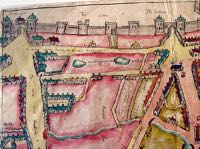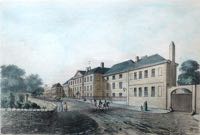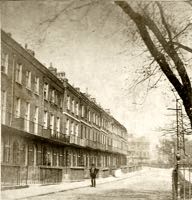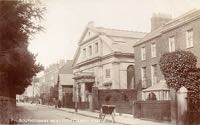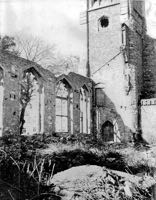
Southernhay
Last update 21st May 2018
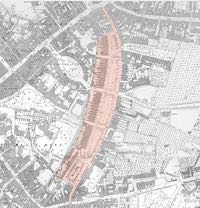 This is thought by many one of the most attractive, tree lined streets in England.
Bordered with fine Georgian townhouses and tastefully designed modern
offices, this is the heart of Exeter's commercial area with banks,
insurance companies, solicitors and regional company headquarters. It
was known as Southernhay as far back as 1265. It follows the line of
the great town ditch, just outside the city wall that was known as
Crulditch. This comes from the word, crull, meaning 'curly', as the ditch followed the
curve of the city wall. Southernhay itself, means the 'southern enclosure'.
This is thought by many one of the most attractive, tree lined streets in England.
Bordered with fine Georgian townhouses and tastefully designed modern
offices, this is the heart of Exeter's commercial area with banks,
insurance companies, solicitors and regional company headquarters. It
was known as Southernhay as far back as 1265. It follows the line of
the great town ditch, just outside the city wall that was known as
Crulditch. This comes from the word, crull, meaning 'curly', as the ditch followed the
curve of the city wall. Southernhay itself, means the 'southern enclosure'.
In 1278 new rules for the running of Lammas Fair were drawn up and that: 'The whole Soyl or Plot of Southenhay is the Lords of the Fair during that time, and till twelve of the Clock the Day after the end thereof' (Izacke) Lammas Fair remained at Southernhay until about 1830 when it was relocated to Bonhay. It is now held on Caathedral Green.
Executions
In November 1557, the unfortunate Agnes Prest was
burnt at the stake in Southernhay for her denial of the doctrine of
transubstantiation. During the Civil War In October 1645, Major Sadler was shot at Southernhay for treason. Sadler had been an officer in the Parliamentary army before defecting to the King. He was captured when Tiverton was taken in October 1645, and court martialled.
It would seem that schemes to make the poor work for little return are not a new idea, for Izacke wrote that Southernhay had been used for a 17th Century
employment scheme. In 1638 the city: 'Ordered that
southenhaye bee foorthw th rayled in & A pitt there be filled vpp w
th earth chiefly to keepe the poore on worke'.
Southernhay becomes a leisure area
It has long been a place for leisure time, where people could stroll among the trees. After Charles II took the throne in 1660, Exeter embarked upon creating new public gardens - the first in the country. Izacke recorded that in 1667:
'A ffootpath in southenhaye to bee made & gravelled & A style there to bee erected to preserve ye said pathe'.... and..... 'Southenhay was now levelled & pleasant walkes made therein & about Two-hundred younge Elmes in several rowes there planted'
Southernhay narrowed at its northern end to join London Inn Square where Paris Street is now located. This top section known as Gatteys Row in 1806, only disappeared when the whole area was rebuilt after the war, and Paris Street, realigned. The modern northern entrance to Southernhay, from Paris Street, cuts through the land formerly occupied by the fine houses of Matthew Nosworthy's Dix's Field.
Georgian Exeter
At its southern end, the (Royal) Devon and Exeter Hospital was built in 1742, on land donated by John Tuckfield, that had formerly been used as a tilt yard and a public space for fairs and horse shows.
Opposite, in the Southgate Hotel car park was the Trinity burial yard. During the 1832 cholera outbreak, some of the victims were buried in the yard, until a riot, caused by the belief that people were either being buried alive or the authorities were not paying enough respect to the departed. According to Cossins, the same ground was used in the 1820's by Wombwell's Menagerie and for other shows from time to time. A bowling green was located on Dix's Field.
After the hospital was built, speculative builders moved in to construct housing for the gentry. Matthew Nosworthy developed Southernhay West with four terraces of fine town houses in the 1790s. Acting as both architect and builder, Nosworthy's houses lent an air of respectability to Southernhay. Two of Nosworthys terraces were lost in the 1942 blitz, when the rear of the houses were destroyed, leaving only a thin facade that was later demolished to become a car park, before it was developed into Broadwalk House.
Southernhay was fast becoming the place for the well-to-do to live as Hooper's 1820 Chichester Place in Southernhay East, and Dix's Field and Barnfield Crescent, both just off Southernhay were developed.
The Bathhouse
In 1821 a rather grand neo-classical bathhouse was constructed on the corner of Southernhay and Dix's Field. A natural spring had been discovered on the site which was utilised to feed the complex of hot, cold, plunge, showers, medicated and fumigated baths – the average Georgian liked to induge in a little sensuous pampering. The facility was open between 7am and 10pm in summer and 8am to 10 in winter – they would even open in an emergency. This was no wash house for the poor, but rather a social meeting place for the wealthy to congregate and discuss the state of the nation and indulge in local gossip. Over the entrance was a classical figure of Poseidon clutching a trident flanked by a mythical seahorse.
By 1850, the facility was under the proprietorship of Mr E W Jackson, who introduced, during the summer months exhibitions of paintings and models under the direction of the Society for the Study and Encouragement of Art. The bath house was being supplied by the city water-works at Pynes, by this time. It was demolished in 1868 and replaced with the Congregational Church.
Bank of England
The Bank of England opened several provincial banks in towns across the country, after there had been a failure of several country banks in 1825. They opened their Exeter branch at 18 Southernhay on 17th December 1827. The front door had a steel plate behind, and removable bars to further strengthen it, and the basement had a strengthened vault installed. Probably because of the loyalty of Exeter's business men to the existing banks around Cathedral Close and the High Street, and Southernhay being relatively inaccessible, the bank lost money and was relocated to Plymouth on the 30th April 1834, making it the shortest lived, provincial Bank of England in the country.
James Cossins, a regular contributor to the Flying Post in the 1870s wrote of his memories of Southernhay when he was a boy:
"Southernhay.-The upper green was an open space, a resort for children to play, also used at fairs and other times for menageries, shows, &c.; the horse fair the other side of the road, (Chichester Place) extending from Dix's Field to the Barnfield, also opposite on one site of No. 2 green. I have seen as many as three hundred tied up awaiting purchasers. It was almost impassable and dangerous with the restlessness, and trying the speed and action of the animals. No. 4, the lower green, was a rough piece of ground, used by children playing; the site of the houses opposite was a deep incline used for depositing refuse from old buildings, &c. At the end, in front of these large old trees, was also used for menageries, shows, &c. In front of the Hospital (which was built in 1741) and down to Magdalen-street road, widened 1827."
Lost to bombs
In Southernhay West, two blocks of houses, north of Bedford Street were destroyed in the blitz, to be replaced by Broadwalk House, which is perhaps one floor too high. On the opposite side, in Southernhay East, the Congregational Church destroyed, leaving just the tower standing. These losses were despite the large tank of water in the centre of Southernhay, for the fire services to draw on.
By the 1970s, the surviving houses of William Hooper and Matthew Nosworthy's Southernhay West were showing signs of age. A major restoration took place. The work has left the front facades largely intact, although the interiors have lost most of their Georgian features. During the renovation, the rear of the gardens were appropriated to make a public path along the wall, from the entrance to Cathedral Close to the South Gate. The northern end of Southernhay has been redeveloped within the Princesshay scheme of the 2000s, in a style that is clearly not fitting to the old Southernhay.
Southernhay people
The Reverend T B Hardy VC MC. DSO, was born in Barnfield House, Southernhay East in 1863 –he is the most highly decorated non-combatant in the British Army. He died from his wounds in 1918 after winning the Victoria Cross in April of the same year.
The actress Violet Vanbrugh was born in Southernhay. Her father, the Rev. Barnes married Frances Nation, in 1866, when she was just 18. Their first child Violet was born on the 11 June 1867 at the Double House 35/6 Southernhay Place, home of France's Mother.
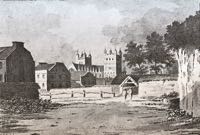
This drawing from circa 1800, shows a view across Southernhay to the Cathedral. The building, centre-left was the New Theatre in Bedford Street. The near gap would become Chichester Place in 1820.
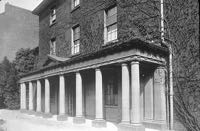
Southernhay House, now a hotel was constructed circa 1800.
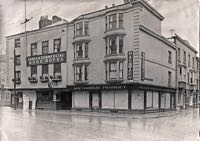
Southernhay narrowed at the northern end, before joining Sidwell Street. The Southernhay Pharmacy was on the corner.
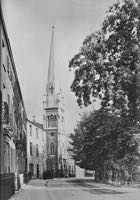
The Southernhay Congregational Church on the corner of Dixs Field. The white house to the left was the birthplace of the Rev Baring Gould, who is noted for penning 'Onward Christian Soldiers'.

The Southernhay Baths were opened in 1821. They were replaced by the Congregational Church.
│ Top of Page │
